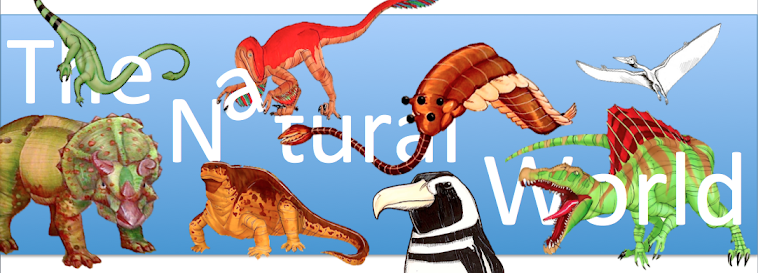Introducing: 23 Fact Tuesdays! I'm thinking that (possibly) each week, we can look at twenty-three different groups of....things....and we can learn a fun fact about them each week! Many of these topics feature
North America, as that is where both I and most of my readers reside, but other topics include
penguins, fossil
horses, fossil
mammals, early humans, various
fish and
birds,
dinosaurs, and many more!
Here they are!
Don't want to read all twenty-three! Well, in my opinion, the best ones are 10, 14, 15, 17, 18, and 19! Enjoy!
1.
Alaskan Mammals: The Sitka black-tailed
deer will graze on beach plants like dune grass and kelp during the lean season.
2.
Alaskan Fish: The whitefish may fast for eight or nine months during the lean season, surviving off of their stored fat.
3.
Dinosaurs: In 1883,
Ceratosaurus was the first large meat eating, or Theropod, dinosaur skeleton that was discovered more than half complete. The first skeleton was discovered in
Colorado.
4.
Dinosaurian Contemporaries:
Lagosuchus was either the direct ancestor, or a close relative of the ancestor, of the dinosaurs.
5.
North American Birds of Prey: The robin-sized
American Kestrel is not only the smallest hawk in
North America, but it is also the most common.
6. Tideland Treasures of
South Carolina: The palmetto, which is the state tree of South Carolina, can live for 75 years, and grow to a height of 60 feet, with a 1 or 2 foot diameter.
7.
North American Mammals: The least chipmunk, besides eating the usual
rodent foods like nuts, will also dine on insects, and occasionally small vertebrates.
8.
North American Hoofed and Marine
Mammals: The
sperm whale is the largest of the toothed
whales.
9.
North American Birds: The common goldeneye will often take over abandoned woodpecker nests.
10. Fossil
Mammals: Despite the fact that primates no longer live in
North America, many
paleontologists think that they either evolved there or in
Asia.
11.
Penguins: Despite the fact that most people think of penguins living in cold, snowy climates, the king penguin typically forms colonies in the shelter of dense tussock grass.
12. Fossil
Horses: One species of
Hypohippus,
H. osborni, had weak and infrequently used side toes. Although not very exciting sounding, this is an important step from multi-toed horse ancestors to the one-toed horses that we know today.
13.
Dinosaurs....Again!:
Ornithomimus, one of the "ostrich-dinosaurs," lived both in the
states of
Colorado and
Montana, but also in the country of
Tibet.
14. Extreme Abilities: In order to protect itself from various predators and to hunt its various prey, the amazing Indo-Malayan octopus can mimic an enormous variety of different animals, including flounder, sea snakes, crinoids, jellyfish, lionfish, hermit crabs, stingrays, brittlestars, stomatopods, and sea anemones, amongst many others.
15. Extreme Movement: Although this dude looks like a worm or something, the caecilian is actually a close relative of newts and salamanders. It lives strictly underground, and is rarely seen, despite the fact that they can grow up to five feet long.
16. Extreme Growth: The
ostrich is a serious
record breaker amongst
birds. Not only does it when the tallest bird and heaviest bird awards, but it also is the fastest runner, has the biggest egg, and has the largest eyes. In fact, the smallest bird on the planet, the tiny little bee hummingbird, could easily fit inside the eye of the ostrich!
17. Extreme Families: The "Biggest Nest of Any
Bird" Award goes to the orange-footed megapode, or the scrubfowl. Although these nests are just on the ground (the biggest nests in trees are built by bald
eagles), they are still very, very impressive. On average, these nests can be 11.5 feet wide and 39 feet tall! The biggest ever recorded, however, was a whopping 164 feet wide!
18. Remarkable
Mammals: The aye-aye, possibly one of the creepiest looking animals in
the natural world, is a type of lemur whose large incisor teeth grow continuously.
19. Remarkable
Birds: Once thought to be the missing link between
reptiles and birds, the
South American Hoatzin hatches out of its egg with claws on its wing greatly resembling those of the ancient
Late Jurassic bird
Archaeopteryx. These wing claws are not often, and maybe even never, found on birds today, with the obvious exception of the baby Hoatzin. As the Hoatzin grows, its wing claws disappear.
20. Remarkable
Fish: The electric eel can discharge fifty volts from its body.
21. Remarkable
Reptiles and
Amphibians: The Cuban tree boa will position itself in small apertures in caves, striking with deadly accuracy at
bats that fly out of the cave. Remarkably, the snake will do this in complete darkness, somehow sensing where the bats are.
22. Prehistoric Animals: Like
Lagosuchus,
Effigia is another possible relative of the
dinosaurs.
23. The Evolution of Humans:
Homo heidelbergensis is thought to have been the last common ancestor between the Neanderthals (
Homo neanderthalensis) and us humans,
Homo sapiens.

No comments:
Post a Comment